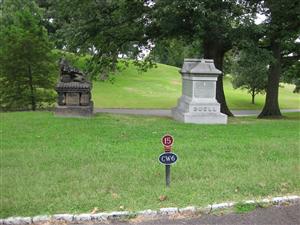
The Don Carlos Buell Grave at Bellefontaine Cemetery [ Waypoint = N38 41.700 W90 13.727 ] is located in Block 114, Lot 77.

Although Don Carlos Buell does not have any direct ties to St. Louis, he is buried in Bellefontaine Cemetery because his wife, Margaret, is buried there. Margaret's first husband, Richard B. Mason, died of cholera in 1849 while stationed at Jefferson Barracks. Margaret chose to be buried next to her first husband. [197]
Born in Ohio, Don Carlos Buell graduated from the Military Academy at West Point in 1841. He served in the Mexican-American War and was recognized three times for bravery. At the beginning of the American Civil War, Brigadier-General Buell briefly commanded a division in the Army of the Potomac. On November 15, 1861, Brigadier-General Buell assumed command of the Federal Department of the Ohio. Buell did not do as his superiors had ordered and conduct operations in eastern Tennessee, leading President Abraham Lincoln to sent the following message: [198]
I would rather have a point on the railroad south of Cumberland Gap than Nashville—first, because it cuts a great artery of the enemy's communication, which Nashville does not; and, secondly, because it is in the midst of loyal people, who would rally around it, while Nashville is not . . . my distress is that our friends in East Tennessee are being hanged and driven to despair, and even now I fear are thinking of taking rebel arms for the sake of personal protection. In this we lose the most valuable stake we have in the South.
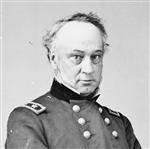
Instead, Buell opted to move on Nashville, Tennessee. It was lightly defended and Buell's forces occupied the city on February 25, 1862. In March, Buell would find himself reporting to Major-General Henry Halleck after Lincoln created the Department of the Mississippi encompassing Buell's Department of the Ohio. Towards the end of March, Halleck ordered Buell and Grant to join their forces at a common location. This location would end up being Pittsburg Landing on the Tennessee River. The Confederates under the command of General Albert Sydney Johnston would attack Grant's Army of the Tennessee on April 6, 1862. Although Grant was pushed back to the river, a division of Buell's Army of the Ohio reached Pittsburg Landing that night, which allowed Grant to attack and defeat the Confederates on April 7th. After the Battle of Shiloh, Buell's Army of the Ohio would participate in the advance on and siege of Corinth, Mississippi [199]


When Confederate General Braxton Bragg invaded Kentucky in the fall of 1862, Buell left Louisville with an army of 100,000 troops to go after Bragg. On October 8, 1862, A single corps of about 16,000 men from Buell's Army of the Ohio fought Bragg in the Battle of Perryville. Unaware that some of his forces were engaged, Buell failed to reinforce them. Both sides suffered very high casualties and Bragg withdrew to East Tennessee. Buell pursued Bragg for a bit and then pulled back to Nashville. As a result of his performance, Buell was replaced in command On October 30th by Major-General William Rosecrans. In addition, US Secretary of War Edwin Stanton ordered a military commission to investigate Buell's actions. It would be 18 months before Buell had another opportunity to command. After he had been promoted to Lieutenant-General, Ulysses S. Grant made a recommendation to US Secretary of War Edwin Stanton that Buell be given another command. Buell was offered his choice of a command under either Major-General William T. Sherman or Major-General Edward Canby. Buell declined saying he couldn't serve under either of them because he outranked them. Grant considered this a pathetic excuse. [200]


The Emmett MacDonald Grave at Bellefontaine Cemetery [ Waypoint = N38 41.530 W90 13.682 ] is located in Block 91, Lot 925.

Born in Ohio, Emmett MacDonald moved to St. Louis, Missouri during the 1850s. In 1861, MacDonald enlisted in the Missouri State Guard. He was the Captain of a cavalry squadron at Camp Jackson and was among those captured on May 10th by the Federal forces under the command of Brigadier-General Nathaniel Lyon. Of all of the captured prisoners, Captain Emmett MacDonald was the only individual who refused to give his parole. On May 14th, Judge Samuel Treat, U. S. Court, Eastern District of Missouri served a Writ of Habeas Corpus on Union Brigadier-General William Harney ordering him to bring Captain Emmett MacDonald to appear in court. Following the hearing, Judge Treat ordered MacDonald released unconditionally. Judge Treat's ruling held that MacDonald could not be a prisoner of war since the militia's assembly at Camp Jackson was legal under Missouri state law. [201]
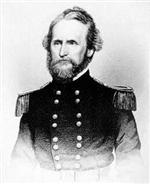
Following his release, Captain MacDonald rejoined his command and fought in the Battle of CarthageBattle of Wilson's Creek, MacDonald provided assistance to Union Surgeon, Dr. S. H. Melcher in recovering Brigadier-General Nathaniel Lyon's body from the battlefield. After Captain Hiram Bledsoe was wounded at Carthage, MacDonald was in command of Bledsoe's Battery during the Siege of Lexington. MacDonald, commanding an artillery battery, fought with distinction at the Battle of Pea Ridge. In Colonel MacDonald led a Missouri cavalry brigade during the Battle of Prairie Grove. [202]
Colonel Emmett MacDonald was in command of MacDonald's Missouri Regiment of Cavalry as part of Marmaduke's raid into Missouri in January 1863. MacDonald received a fatal wound to his thigh and died during the Battle of Hartville on January 11, 1863. Major G. W. C. Bennett, who assumed command of the regiment after MacDonald's death, said the following about Colonel MacDonald: [203]
During this engagement he fell, mortally wounded in the thigh. Of his action on this occasion, others who were present have a better right to speak than myself. Surely none that knew him will pretend to say he did not die gallantly battling with the enemy--bravely fighting for his country and his country's cause. During my connection with the army I have never known a kinder-hearted man--a braver officer or soldier. Let us drop one tear upon the grave of the departed hero, and pass on to renewed victories and to avenge his death.

The Bernard G. Farrar Grave at Bellefontaine Cemetery [ Waypoint = N38 41.605 W90 13.695 ] is located in Block 102, Lot 580.

Bernard G. Farrar, Jr. was born in St. Louis to slave-holding parents. Farrar, himself, was a slave-owner, but became a Free-Soiler in 1854 and aligned himself with Francis P. Blair, Jr. to fight against Missouri secessionists. Farrar volunteered for Federal service in 1861 and served as Brigadier-General Nathaniel Lyon's aide in 1861. In this capacity, Major Farrar carried Lyon's ultimatum of surrender to the commander at Camp Jackson, Brigadier-General Daniel Frost. When Lyon was in Springfield and desperately in need of supplies and reinforcements, he sent Major Farrar to St. Louis to see Major-General John C. Fremont. [204]
Shortly after Major-General Henry Halleck assumed command of the Department of the Missouri, he established a provost-marshal system in his department. On December 4, 1861, Halleck appointed Lieutenant-Colonel Farrar as the Provost-Marshal for the Department of the Missouri. When Halleck assumed command of the Department of the Mississippi, he appointed Lieutenant-Colonel Farar to continue as Provost-Marshal in that department. [205]
On October 31, 1862, Colonel Farrar became the commanding officer for the Thirtieth Missouri Volunteer Infantry Regiment. This regiment was assigned to First Brigade in the First Division in Major-General William T Sherman's Fifteenth Army Corps. As such, Farrar was part of Major-General Ulysses S. Grant's Army of the Tennessee's operation against Vickburg. Colonel Farrar assumed command of the First Brigade on June 13, 1863. [206]
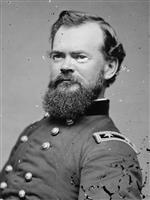
Detached to the Seventeenth Army Corps, his new commander, Major-General James B. McPherson made the following statement about Farrar's service: [207]
Colonel Farrar has shown himself a bold, adventurous, and skillful partisan, and in his recent operations about Natchez has rendered most efficient service. His forte lies in commanding a small body of resolute, daring men.
Colonel Farrar was next appointed to command the Defenses of Natchez, Mississippi. On September 12, 1863 raised a regiment of colored troops originally designated the Second Mississippi Heavy Artillery (African Descent). It would be re-designated the Fifth U. S. Colored Heavy Artillery on March 11, 1864 and then the Sixth U. S. Colored Heavy Artillery on April 26, 1864. On January 19, 1865, Colonel Farrar was appointed to command the post of Natchez, Mississippi. By March 1865, Farrar had received a brevet promotion to Brigadier-General. On May 8, 1865, Brigadier-General Farrar took a leave of absence and returned to civilian life in St. Louis, Missouri. [208]
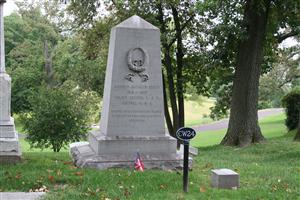
The Andrew Jackson Smith Grave at Bellefontaine Cemetery [ Waypoint = N38 41.649 W90 13.712 ] is located in Block 104, Lot 11.

Born in Pennsylvania, Andrew Jackson Smith graduated from the United States Military Academy at West Point in 1837. Smith served with distinction in the Mexican-American War. At the start of the Civil War, Smith enlisted and was appointed Colonel of the Second California Volunteer Cavalry. During the winter of 1862, Smith was promoted to Brigadier-General of Federal Volunteers and assigned to Henry Halleck's Department of the Missouri where he served as the department's Chief of Cavalry. Smith participated in Halleck's advance and siege of Corinth. In the fall of 1862, Smith would command the First Division in Major-General Gordon Granger's Army of Kentucky. Assigned to Grant's Army of the Tennessee later that winter, Smith would take part in the operations against Vicksburg as commander of the First Division in Sherman's Thirteenth Army Corps. [209]
After the fall of Vicksburg, Brigadier-General Smith was relieved of his divisional command in the Army of the Tennessee and appointed to be the commander of the District of Columbus, Kentucky. In the Spring of 1864, Detached to Major-General Nathaniel Banks for the Red River (Louisiana) Campaign, Brigadier-General Smith would lead detachments from the Sixteenth and Seventeenth Army Corps on the expedition into Louisiana. [210]
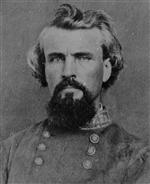
In July 1864, Major-General Smith led his troops in the right wing of the Sixteenth Army Corps in a victory against Confederate General Nathan Bedford Forrest in the Battle of Tupelo. On his way to reinforce Sherman in Atlanta, Smith, in command of two divisions of about 10,00 men, was ordered on September 7, 1864 to halt in Cairo, Illinois. Federal authorities believed that Confederate Major-General Sterling Price was about to invade Missouri. On September 9th, Smith was given the order to cross the Mississippi River and move against Price's Army. Smith never did catch up with Price and was ordered east to Tennessee, having marched over 400 miles in 18 days in Missouri. [211]

Major-General Smith next took his two divisions to Nashville, Tennessee to join forces with the Army of the Cumberland, commanded by Major-General George Henry Thomas. Smith's forces would take part in the Franklin-Nashville Campaign against Confederate General John bell Hood. Over a two-day period from December 15-16, 1864, the Battle of Nashville raged ending in a devastating defeat of Hood's Confederate army. [212]
Next up for Major-General Smith was command of the entire Sixteenth Army Corps and orders to report with his command to Major-General Edward Canby at New Orleans. His corps would participate in the Campaign against Mobile, Alabama and fought in the Union victory in the Battle of Fort Blakely during April 1865. [213]
After retiring from the military service, Smith became the postmaster of St. Louis, Missouri in April 1869.

The Hamilton R. Gamble Grave at Bellefontaine Cemetery [ Waypoint = N38 41.655 W90 13.778 ] is located in Block 96, Lot 874.
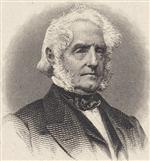
Born in Virginia, Hamilton Rowan Gamble moved to St. Louis, Missouri in 1818. Gamble re-located to Franklin in Howard County, Missouri. Missouri's second Governor, Frederick Bates, appointed Gamble as his Secretary of State. After Governor Bates died in office, Gamble returned to St. Louis to practice law. Eventually gamble became law partners with Edward Bates, brother of the former Governor. In 1846, Gamble was elected to the Missouri State Legislature. In 1851, Hamilton R. Gamble became the Chief Justice of the Missouri State Supreme Court. In 1852, Chief Justice Gamble would issue the lone dissenting opinion in the case of Dred Scott (A Slave) Against Irene Emerson For False Imprisonment and Assault, in which the Missouri Supreme Court ruled that Dred Scott was still a slave. [214]
In 1861, Hamilton R. Gamble would be elected to represent St. Louis as a delegate to the Missouri State Convention during which the delegates would decide whether or not Missouri would secede from the United States of America. Following the Camp Jackson Affair, Gamble would travel to Washington to meet with Attorney General Edward Bates and President Abraham Lincoln. They felt strongly that Brigadier-General Nathaniel Lyon was too radical and should be removed from command. Following the Battle of Boonville which sent Missouri Governor Claiborne Jackson into exile, the Missouri State Convention came together in order to appoint a Provisional Governor. The convention elected Hamilton R. Gamble to be Missouri's wartime Governor. In poor health, Gamble submitted his resignation in 1863, but the Missouri State convention refused to accept it. Hamilton R. Gamble died in office on January 31, 1864. His health had been deteriorating and after suffering a fall on the ice, Gamble contracted pneumonia from which he died. [215]

The Sterling Price Grave at Bellefontaine Cemetery [ Waypoint = N38 41.662 W90 13.796 ] is located in Block 96, Lot 1734.

Born in Virginia, Sterling Price moved to Missouri in 1831 and finally settled in Keytesville, Missouri. Price quickly became involved in Missouri politics and, after a break to serve in the Mexican-American War, became the Governor of Missouri in 1853. When the American Civil War broke out, Sterling Price was appointed a Major General and placed in command of the pro-southern Missouri State Guard by Missouri Governor Claiborne Fox Jackson. Early in the war, Price led the Missouri State Guard to victories in the Battle of Wilson's Creek and the Battle of Lexington and then to defeat in the Battle of Pea Ridge. In 1864, Price, then a Major General for the Confederacy, led a cavalry raid into Missouri that ultimately resulted in an overwhelming defeat. The Civil War Muse has written an extensive biography of Sterling Price.